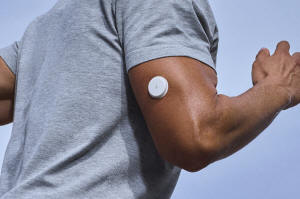Continuous glucose monitors are in vogue. But do you really need to
track your blood sugar?
[July 28, 2025]
By JONEL ALECCIA
A quarter-size device that tracks the rise and fall of sugar in your
blood is the latest source of hope — and hype — in the growing buzz
around wearable health technology.
Continuous glucose monitors, small patches that provide 24-hour insight
into concentrations of sugar in the blood, could be a tool for Americans
to “take control over their own health,” Health Secretary Robert F.
Kennedy Jr. recently told federal lawmakers.
“They can take responsibility,” Kennedy said. “They can begin to make
good judgments about their diet, about their physical activity, about
the way they live their lives.”
The devices have lifesaving benefits for people with diabetes, the
disease caused when blood sugar remains high because their bodies don't
make enough insulin or become resistant to it. The condition, which
affects more than 38 million people in the U.S., raises the risk of
serious health problems such as heart and kidney disease and vision
loss.
But the devices have surged in popularity among people without diabetes.
Sales have been driven by high-profile marketers such as Casey Means,
the nominee for U.S. surgeon general.
There’s scant evidence the monitors are useful for people with normal
blood sugar levels, said Dr. Jody Dushay, an endocrine specialist at
Beth Israel Deaconess Medical Center.
Healthy bodies can effectively regulate glucose after meals and provide
the energy they need to function. Glucose monitors may lead people to
misinterpret normal swings in blood sugar that happen after eating or
activity. In addition, the devices can be “notoriously inaccurate,”
providing misleading readings, she said.
“The problem with wearing these is that you can just be zooming in on
and creating pathology when it’s not there,” Dushay said.
Here’s what you need to know about the devices:

Here's what a continuous glucose monitor does
The device is a small patch, about the size of two stacked quarters,
usually placed on the upper arm or stomach. It uses a needle to
painlessly pierce the skin for a tiny sensor.
The sensor measures the glucose in fluid under the skin, delivering a
signal every few minutes to a phone app or a handheld display. The apps
typically record blood sugar levels and help people track the foods they
eat and how they impact those levels.
When healthy people eat a meal that contains carbohydrates, their blood
sugar rises, peaks and falls in response to the food.
A healthy fasting blood glucose level for a person without diabetes is
roughly 70 milligrams per deciliter to 99 milligrams per deciliter. A
range from 100 to 126 milligrams per deciliter indicates prediabetes and
above 126 milligrams per deciliter indicates diabetes, according to the
American Diabetes Association.
In adults without diabetes, blood sugar levels can climb to 140
milligrams per deciliter or more within an hour of a meal, before
falling back to baseline levels within two or three hours, according to
the association. It's a sign the body is processing sugar normally.
[to top of second column]
|

This image provided by Abbott’s Lingo division in July 2025, shows
the Lingo wearable device for continuous glucose monitoring.
(Abbott/Lingo via AP)
 Continuous glucose monitors have
been available since the late 1990s
For decades, these devices were available only for people with
diabetes. The monitors revolutionized care by allowing more precise
adjustment of insulin used to treat diabetes and giving people the
ability to modify meals and activity more accurately.
Last year, the U.S. Food and Drug Administration approved the first
over-the-counter monitors. Since then, many companies have emerged
to market them, claiming to provide intensive, individualized health
monitoring. Cost is generally about $100 a month.
They’ve really caught on with consumers curious about how food and
activity affect their blood sugar levels. For instance, Noom, the
weight-loss and fitness app, launched a blood glucose feature last
year that has proven extremely popular, said Alexander Fabry, a
company executive.
“Of the people who are using a CGM, the vast majority of them don’t
have a diabetes diagnosis,” he said.
Who can use the monitors?
The devices have been lifesaving for people with diabetes. And they
can be helpful for people with risk factors for the disease,
including obesity, prediabetes, a history of gestational diabetes or
a family history of the condition.
The devices can allow users to see how specific food and activity
choices affect their blood sugar in near real-time, said Dr. Alaina
Vidmar, a pediatric obesity specialist at Children’s Hospital Los
Angeles.
“After a large meal, you may watch your blood sugar go up and sort
of learn something about yourself,” Vidmar said. “For example, I
drink a sugar-sweetened soda and my blood sugar goes up really high,
really fast. And maybe I don't feel as good, right?”
What are the cautions?
People without risk factors for diabetes may turn to the monitors
just because they’re curious, said Dr. David Kessler. A former FDA
commissioner, Kessler doesn’t have diabetes, but he wore a monitor
for a couple months during research for his recent book, “Diet,
Drugs and Dopamine.”
“I think it’s a very interesting tool to experiment with if you’re
so inclined,” Kessler said.
But, he noted, the devices can’t be used to diagnose or treat
disease. Even experts don't agree on how to interpret or provide
health advice for people without diabetes based on blood sugar data.
“No one knows what’s optimal in the nondiabetic state,” he said.
Before using a monitor, Dushay asks patients to consider their
motives.
“What do you think you're going to get from the data?” she said.
“What is to be gained from wearing that monitor?”
All contents © copyright 2025 Associated Press. All rights reserved
 |